Click here to get SN Dey Class 11 All Chapters Solutions
SN Dey Class 11 Differentiation Short Answer Type Questions Solutions
SN Dey class 11 Differentiation short answer type questions Ex 1 solutions:
Ex 1: Examine whether f(x)=|x+1| has a derivative at x=-1.
Solution:
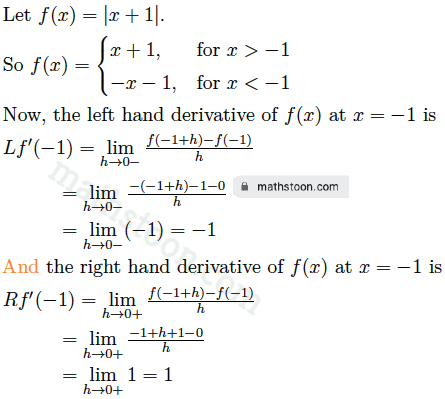
As $Lf'(-1) \neq Rf'(-1)$, we conclude that f(x)=|x+1| has no derivative at x=-1.
SN Dey class 11 Differentiation short answer type questions Ex 2 solutions:
Ex 2: If the derivative of f(x) at x=a is $f'(a)$, show that
$\lim\limits_{x \to a}\dfrac{xf(a)-af(x)}{x-a}$ $=f(a)-af(a)$
Solution:
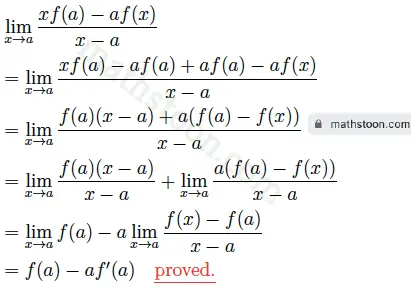
SN Dey class 11 Differentiation short answer type questions Ex 3 solutions:
Ex 3: Find from the first principle, the derivatives of the following function:
Ex 3.(i): From the first principle, find the derivative of x3.
Solution:
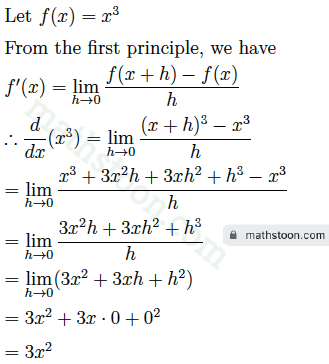
Ex 3.(ii): From the first principle, find the derivative of x6.
Solution:
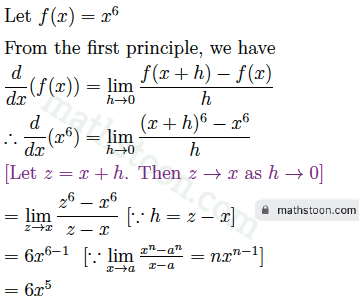
| Derivative of square root of x : The derivative of root x is 1/2√x. |
Ex 3.(iii): From the first principle, find the derivative of √x.
Solution:
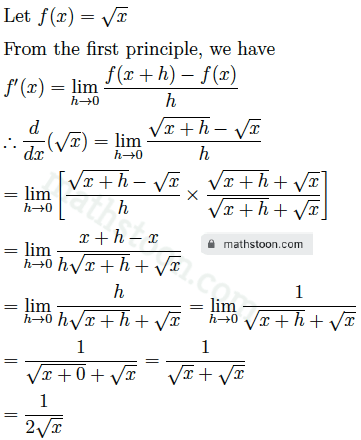
Ex 3.(iv): From the first principle, find the derivative of tan $\frac{x}{2}$.
Solution:
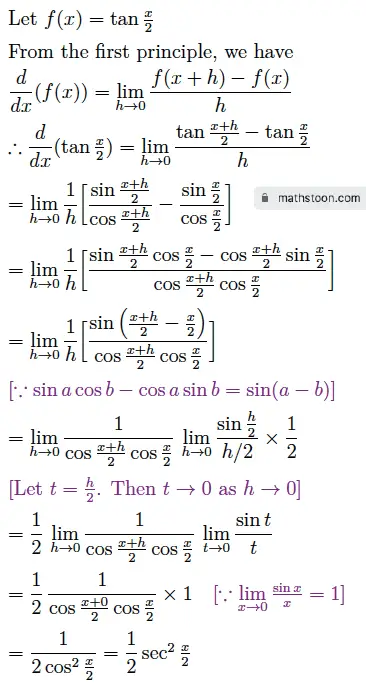
Ex 3.(v): From the first principle, find the derivative of sec 3x.
Solution:
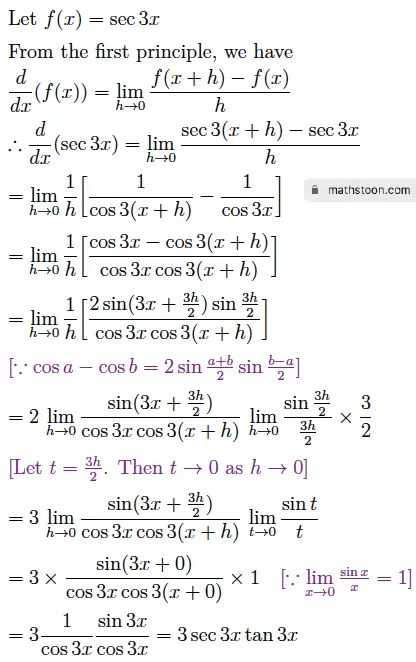
Ex 3.(vi): From the first principle, find the derivative of sin 4x.
Solution:
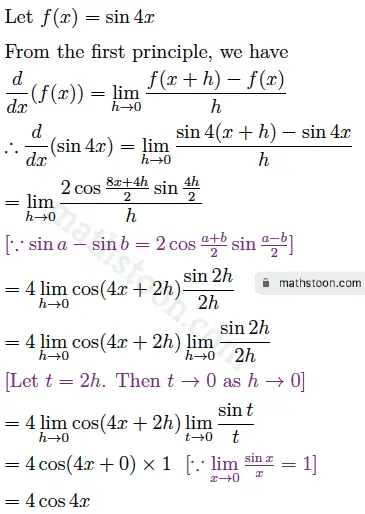
Ex 3.(vii): From the first principle, find the derivative of sin x°.
Solution:
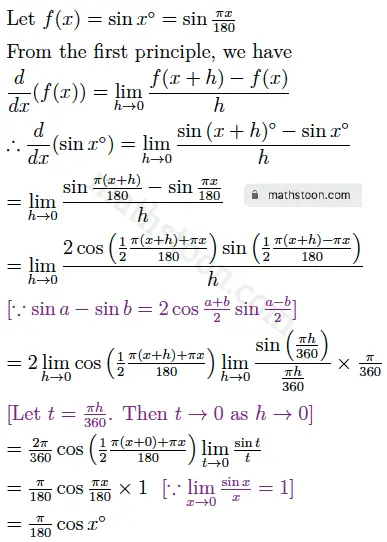
Ex 3.(viii): From the first principle, find the derivative of 1/√x.
Solution:
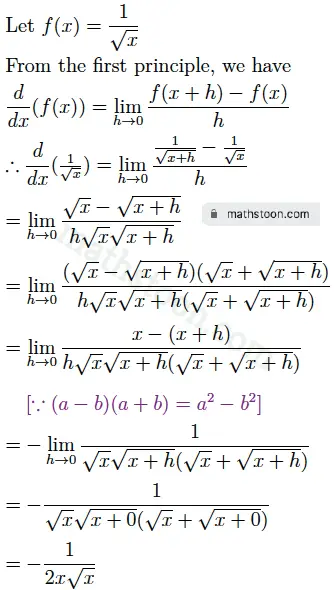
Ex 3.(ix): From the first principle, find the derivative of e3x.
Solution:
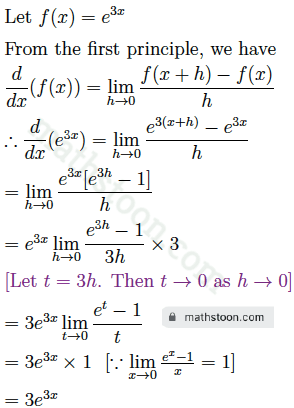
Ex 3.(x): From the first principle, find the derivative of 3√x.
Solution:
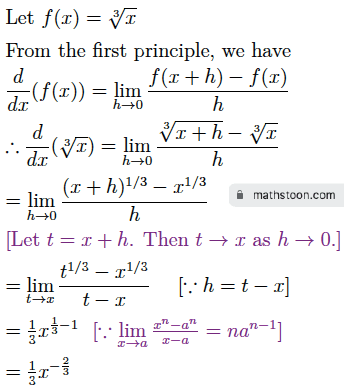
Ex 3.(xi): From the first principle, find the derivative of log 3x.
Solution:
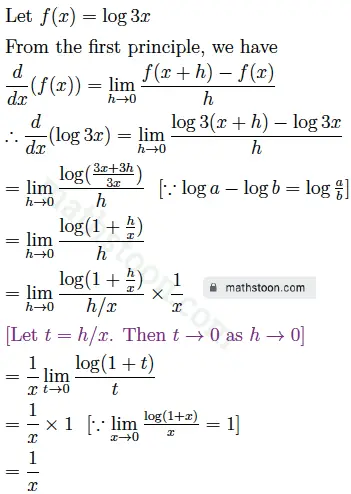
Ex 4: Find from the definition of the differential coefficients of the following function:
Ex 4.(i): y=x+$\frac{1}{x}$ at x=1.
Solution:
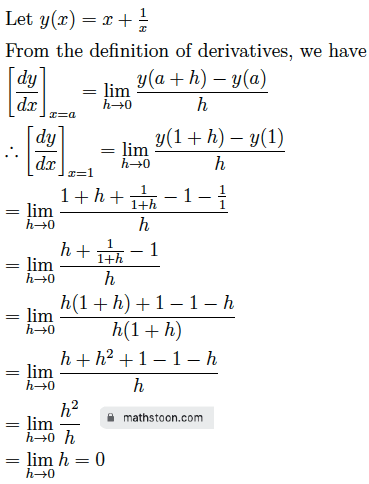
Ex 4.(ii): y=4 at x=3.
Solution:
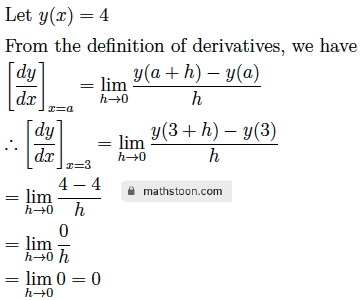
Ex 4.(iii): y=$\frac{1}{2x+3}$ at x=0.
Solution:
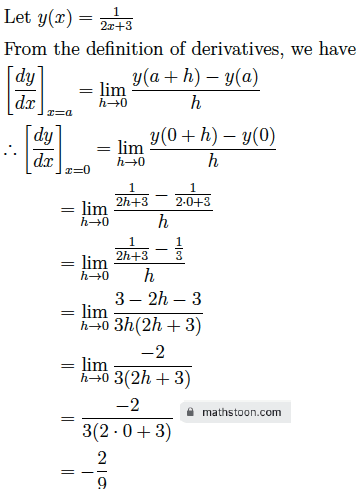
Ex 4.(iv): y=sec 2x at x=$\frac{\pi}{6}$.
Solution:
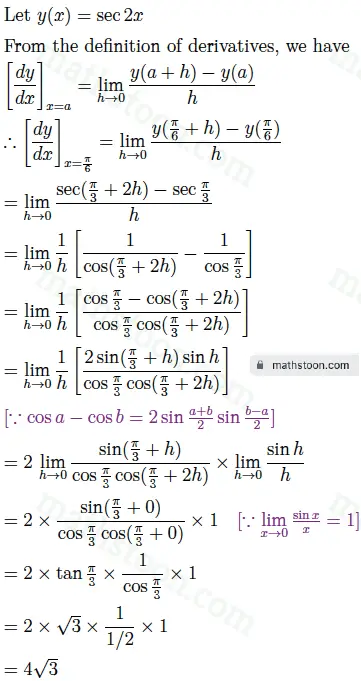
Ex 4.(v): y=√x at x=2.
Solution:
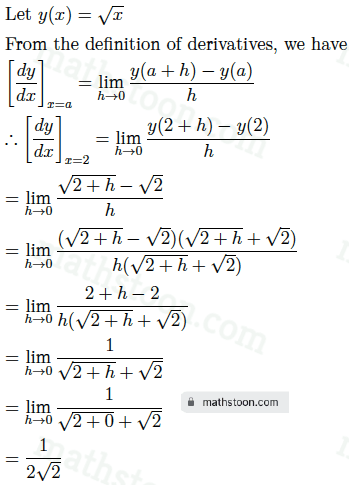
Ex 4.(vi): y=x2/3 at $x=\frac{1}{27}$.
Solution:
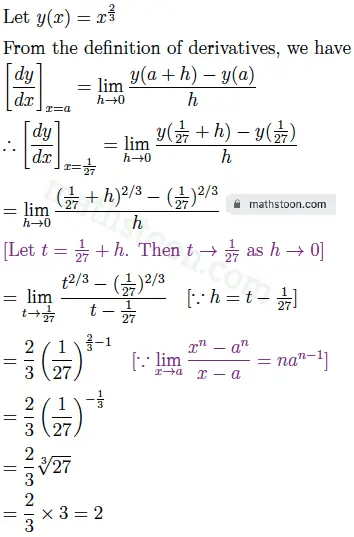
Ex 4.(vii): y=e-2x at x=0.
Solution:
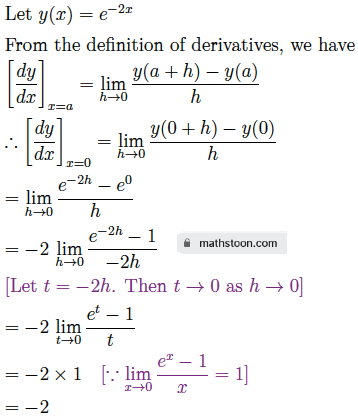
Ex 4.(viii): y=cot $\frac{x}{2}$ at x=$\pi$.
Solution:
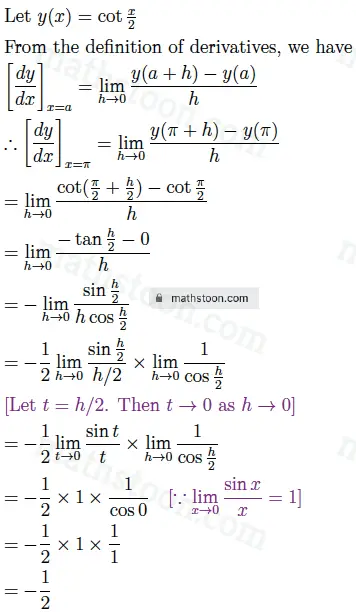
Ex 4.(ix): y=cos 2x at x=$\frac{\pi}{4}$.
Solution:
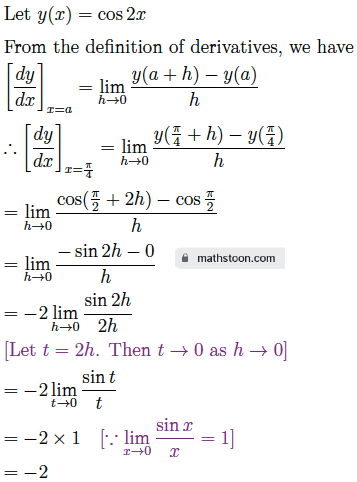
Ex 6: Differentiate the following functions with respect to x:
Ex 6.(i): 10x ⋅ x10
Solution: The derivative of 10x ⋅ x10 is equal to
d/dx(10x ⋅ x10) = 10x d/dx(x10) + x10 d/dx(10x) , by the product rule of derivatives.
= 10x ⋅ 10x10-1 + x10⋅10x loge10
= 10x+1 ⋅x9 + x10⋅10x loge10
Ex 6.(ii): x3log x
Solution:
d/dx(x3 log x) = x3 d/dx(log x) + log x d/dx(x3)
= x3 ⋅ 1/x + log x ⋅ 3x2
= x2 + 3x2 log x
= x2 (1 + 3log x)
Ex 6.(iii): ex tan x
Solution: The derivative of ex tan x is equal to
d/dx(ex tan x) = ex d/dx(tan x) + tan x d/dx(ex) , by the product rule of derivatives.
= ex ⋅ sec2x + tan x ⋅ ex
= ex (tan x + sec2x)
Ex 6.(iv): √x log √x
Solution:
d/dx(√x log √x) = √x ⋅ d/dx(log √x) + log √x ⋅ d/dx(√x)
$=\sqrt{x} \frac{1}{\sqrt{x}} \frac{d}{dx}(\sqrt{x})$ $+\log \sqrt{x} \frac{d}{dx}(\sqrt{x})$
$=\frac{d}{dx}(x^{1/2}) (1+\log \sqrt{x})$
$=\frac{1}{2} x^{1/2-1} (1+\log \sqrt{x})$
$=\frac{1}{2\sqrt{x}} (1+\log \sqrt{x})$
Ex 6.(v): (x2+1)ex
Solution:
d/dx{(x2+1)ex} = (x2+1) d/dx(ex) + ex d/dx(x2+1)
= (x2+1) ex + ex (2x+0)
= ex (x2+1+2x)
= ex (x+1)2
Ex 6.(vi): ex sec x
Solution:
The derivative of ex sec x is equal to
d/dx(ex sec x) = ex d/dx(sec x) + sec x d/dx(ex) , by the product rule of derivatives.
= ex ⋅ sec x tan x + sec x ⋅ ex
= ex sec x (tan x + 1)
Ex 6.(vii): (2x-5)(x2+2)
Solution:
Ex 6.(viii): cosec x ⋅ cot x
Solution:
The derivative of cosec x ⋅ cot x is equal to
d/dx(cosec x ⋅ cot x) = cosec x d/dx(cot x) + cot x d/dx(cosec x) , by the product rule of derivatives.
= cosec x ⋅ (-cosec2 x) + cot x ⋅ (-cosec x cot x)
= -cosec x (cosec2x+cot2x)
Ex 6.(ix): (sin x +sec x)(cos x +cosec x)
Solution:
The derivative of (sin x +sec x)(cos x +cosec x) is equal to
d/dx[(sin x +sec x)(cos x +cosec x)]
= (sin x +sec x) d/dx(cos x +cosec x) + (cos x +cosec x) d/dx(sin x +sec x)
= (sin x +sec x) (-sin x -cosec x cot x) + (cos x +cosec x) (cos x +sec x tan x)
Ex 6.(x): sec3 x
Solution: The derivative of sec3x is equal to
d/dx(sec3 x) = 3 sec2 x ⋅ d/dx(sec x)
= 3 sec2 x ⋅ sec x tan x
= 3 sec3 x tan x
Ex 6.(xi): √xex sec x
Solution:
Ex 6.(xii): xtan x log x
Solution:
Ex 6.(xiii): x cos x + 2x sec x
Solution:
The derivative of x cos x + 2x sec x is equal to
d/dx(x cos x + 2x sec x) = d/dx(x cos x) + d/dx(2x sec x)
= x d/dx(cos x) + cos x d/dx(x) + 2x d/dx(sec x) + sec x d/dx(2x)
= x sin x + cos x ⋅ 1 + 2x sec x tan x + sec x ⋅ 2xloge2
= x sin x + cos x + 2x sec x (tan x + loge2)
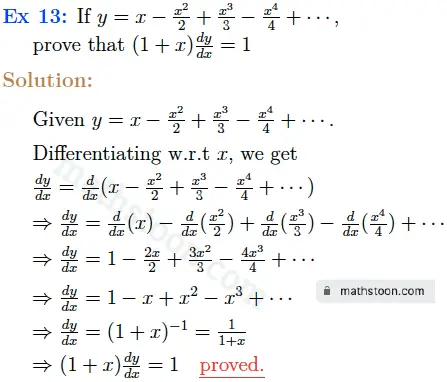
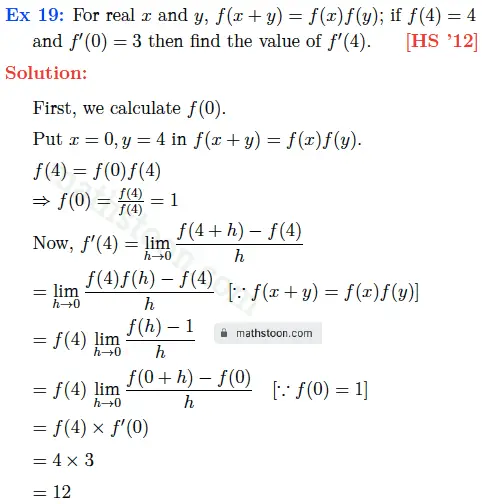
Keywords: SN Dey Class 11 Differentiation Solutions | Solution of Class 11 Derivative | SN Dey Class 11 Solutions | SN Dey Class 11 Derivative Solutions Short Answer Type Questions | WB Board Class 11 Derivative Solution | SN Dey Class 11 Math Chapter Derivative Solution | Differentiation Short Answer Type Questions Answers | sn dey class 11 derivatives solutions
This article is written by Dr. T, an expert in Mathematics (PhD). On Mathstoon.com you will find Maths from very basic level to advanced level. Thanks for visiting.